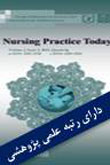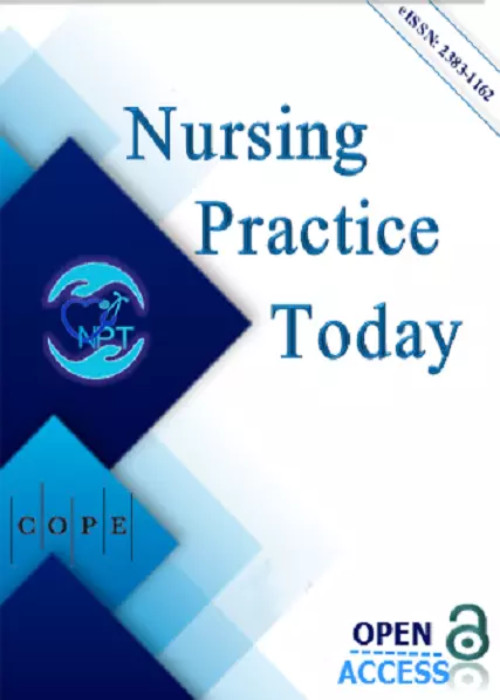فهرست مطالب

Nursing Practice Today
Volume:3 Issue: 4, Autumn 2016
- تاریخ انتشار: 1395/12/20
- تعداد عناوین: 7
-
-
Pages 124-127
-
Pages 128-139Background and AimThe number of cancer patients has been continuously increasing due to early diagnosis and the developments in cancer treatment. This has led to an increase in psychosocial problems associated with the diagnoses and treatment of cancer. Loneliness is emphasized to be one of the most frequently observed psychological symptoms in cancer patients. Personal and external factors that cause stress in life and insufficient social support increase the level of loneliness in patients. This systematic review aimed to determine the effect of education and social support provided to the patients diagnosed with cancer on their loneliness.
Methods & Materials: This systematic review was prepared in accordance with the Preferred Reporting Items for Systematic review and Meta-Analysis Protocols (PRISMA-P) protocol. The databases of PubMed, CINAHL, ScienceDirect, Web of Science, Cochrane Library, Ulakbim Turkish Medical Index, and Turk Medline were scanned to August 31, 2016, without a limitation of date. The keywords used during the scanning were cancer and loneliness, and cancer patients and loneliness. Five studies were included in this review keeping in consideration the inclusion and exclusion criteria.ResultsThe results of the studies included in this systematic review revealed the positive effect of education and social support on the sense of loneliness observed in cancer patients. Three of five randomized controlled studies found that education and social support positively affected loneliness.ConclusionThe results of this review showed that the education and social support provided to cancer patients should be increased, and sociocultural factors should be considered while planning education and social support.Keywords: cancer, education, loneliness, social support, systematic review -
Pages 140-151Background and AimNowadays, home health care services play significant roles in modern societies. Such services allow the elderly and needy people to pass their treatment process at their own houses in a friendly environment. In this paper, weekly routing and scheduling problem of home health care personnel was investigated.
Methods & Materials: Insufficient number of expert personnel or overlapping time windows of some patients would result in delayed beginning of the service time for patients. This paper attempted to solve multi-period multi-depot routing-scheduling problem with regard to the delay in giving services to patients, simultaneously. Presented model is solved by GAMS software in small scale and hybrid genetic-imperialist competitive algorithm in large scale.ResultsFor planning and managing the home health care institutions activity, it must be determined that which personnel will visit the patient and when the visit is met. This paper, considering the probable delay in giving services to the patients, would determine the best plan for personnel visit. Starting time of each visit, number of patients that would be assigned to each personnel, occurred delay in patients visits, and each personnels overtime are the results of the proposed paper.ConclusionProposed model will minimize home health care institutions total cost and increase the satisfaction of patients through minimizing the occurred delay. Also, the hybrid algorithm indicates good performance for the model of this paper.Keywords: homecare services, community health planning, mathematical concepts, patient satisfaction -
Pages 152-160Background and AimHigh levels of anxiety in mothers after the birth of a premature infant and its negative effects and consequences on the infant and the family indicate the necessity of performing an intervention for them. This study was conducted to evaluate the effect of neonatal intensive care unit orientation program on the anxiety of premature infants mothers in Shahrekord.
Methods & Materials: In this semi-experimental non-equivalent controlled study which was conducted in 2015, 64 mothers of premature infants were enrolled who were allocated into two groups of control and intervention. Participants of the intervention group participated in three 30-minute face-to-face unit orientation educational program. Data were gathered using the Spielbergers State-Trait Anxiety Inventory that has 40 questions and were analyzed using central indices, dispersion, Kolmogorov-Smirnov test, Chi square, Fishers exact test, independent t-test and Mann-Whitney test.ResultsThe mean score of anxiety of the mothers had no significant difference between the control group (102.16 ± 4.72) and the intervention group (100.12 ± 1.66) before the intervention (p > 0.05). The mean score of both groups still had no significant difference after the intervention (p > 0.05). Also comparing the mean score of the trait anxiety and the situational anxiety subgroups between both groups before and after the intervention showed no significant difference (p > 0.05).ConclusionConsidering the ineffectiveness of the neonatal intensive care unit orientation program on the anxiety of mothers, it seems that this method could not decrease mothers anxiety on its own. Therefore it is necessary to evaluate the effect of other interventions on the anxiety of premature infants mothers in future studies.Keywords: orientation programs, anxiety, mothers, neonatal intensive care unit -
Pages 161-170Background and AimThe fear of childbirth is defined as the fear experienced before, during and after birth. This study was carried out to study the relationship between fear of childbirth and obstetric variables.
Methods & Materials: This cross sectional study was conducted in a State Hospital in Kars, Turkey on 403 pregnant women who were recruited from the delivery ward. The convenience sample included pregnant women who could speak and read Turkish, had a single fetus, were without a high risky pregnancy and were in the latent phase of labor. Exclusion criteria were experiencing high-risk conditions associated with their birth. Data were collected using three questionnaires; a survey form including socio-demographic and obstetric characteristics, the Wijma Delivery Expectance/ Experience Questionnaire (W-DEQ/A), and the Turkish version of Beck Anxiety Inventory (BAI).ResultsThe W-DEQ/A and BAI scores were higher in the nulliparous than multiparous (W-DEQ/A 67.08±28.33, 59.87±26.91, P=0.039ConclusionThe severe fear of childbirth and anxiety was more common in the nulliparous women, mothers with history of pre- term, and post-term pregnancy and in those who did not receive prenatal care and had vaginal delivery.Keywords: fear of birth, parity, prenatal care, Turkey -
Pages 171-178Background and AimCancer is a significant and global health problem that negatively affects the functional status. The aim of this study was to investigate the relationship between perceived social support, functional status and demographic characteristics in cancer patients.
Methods & Materials: This cross-sectional study was conducted with 243 patients with cancer, who met the research criteria and got treatment in the medical oncology clinic and chemotherapy unit in 2011. In the research, "Patient Information Form" was used to identify the socio-demographic and medical characteristics of the patients, "Functional Living Scale (FLS) - Cancer" was used to assess their functional statuses, and "Cancer Patients Social Support Scale" was used to assess their perceived social support. Data analysis was performed by descriptive statistics tests, One -Sample T Test, Kruskal-Wallis test, Pearson Correlation and regression test. The statistical significance level was determined as pResultsIn this study, there was positive correlation between perceived social support and functional living. There was statistically significant relationship between diagnosis and educational status with FLS. There was statistically significant relationship between age, gender, marital status, educational status, disease duration and social support.ConclusionIn this study, patients functional living status improves as the perceived social support increases. Therefore, interventions to improve functional living status and social support of patients Can be synergistic.Keywords: cancer, social support, functional status -
Pages 179-186Background and AimAlthough cold and heat have been recommended for labor pain relief, comparison of them and intermittent change in cold and heat therapy has been less considered. This study compared the effects of separate and intermittent heat and cold on labor pain relief and some birth outcomes.
Methods & Materials: This was a randomized clinical trial. Ninety-six parturient women were randomly allocated to three groups. The heat therapy group received warm water bags and the cold therapy group received ice bags over abdomen, lower abdomen and low back, intermittently based on mother's preference, in the first stage and also over perineum in the second stage of labor. In the intermitted heat and cold group, a warm water bag was used followed by an ice bag during the active phase, and the second stage. Pain severity was assessed by a visual analogue scale. Duration of labor, mother's satisfaction and fetal and neonatal outcomes were assessed. Mean, standard deviation, frequency, Chi-square, ANOVA and repeated measurement were used for data analysis.ResultsAlthough pain intensity was slightly lower in the heat therapy group during labor, it was not significantly different between three groups. The duration of the second stage was significantly lower in the cold therapy group (p=0.02), There were not significant differences in duration of the first and third stages, fetal heart rate and Apgar score between the groups. Mother's satisfaction was high in 56.2% of the heat and the intermittent heat and cold therapy groups compared to 37.5% in the cold therapy group (p>0.05).ConclusionTo provide pain relief during labour, application of heat and cold, either separate or intermittent can be used based on the mother's preference.Keywords: cryotherapy, heat therapy, heat therapy, pain management


